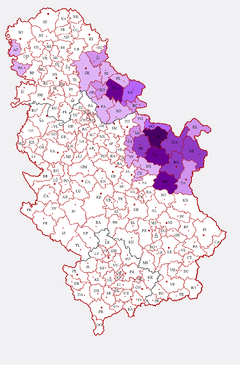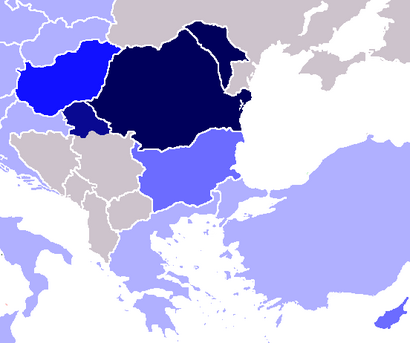Romblomanon Numerals facts for kids
Quick facts for kids Romanian |
||||
|---|---|---|---|---|
| Daco-Romanian limba română |
||||
| Native to | Romania, Moldova | |||
| Ethnicity | Romanians (incl. Moldovans) | |||
| Native speakers | 24–26 million (2016)e19 Second language: 4 million L1+L2 speakers: 28–30 million |
|||
| Language family | ||||
| Early forms: |
Proto-Romanian
|
|||
| Dialects |
Transylvanian
Crișana
Moldavian
Banat
Wallachian
Maramureș
Bukovinian
|
|||
| Writing system | Latin (Romanian alphabet) Cyrillic (Transnistria only) Romanian Braille |
|||
| Official status | ||||
| Official language in | ||||
| Recognised minority language in | ||||
| Regulated by | Romanian Academy Academy of Sciences of Moldova |
|||
| Linguasphere | 51-AAD-c (varieties: 51-AAD-ca to -ck) | |||
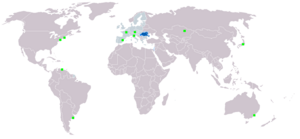
Blue: region where Romanian is the dominant language. Green: areas with a notable minority of Romanian speakers.
|
||||
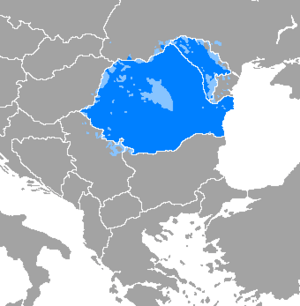
Distribution of the Romanian language in Romania, Moldova and surroundings.
|
||||
|
||||
Romanian is a language spoken by about 24 to 26 million people. Most of these speakers live in Romania and Moldova. Another 4 million people speak Romanian as a second language. This means around 28 to 30 million people worldwide can speak Romanian.
Romanian is the official language in both Romania and Moldova. It is also one of the official languages of the European Union.
This language belongs to the Romance languages group. This group includes languages like French, Italian, and Spanish. All these languages grew from Vulgar Latin. Vulgar Latin was the everyday Latin spoken by common people in the Roman Empire. Romanian is part of the "Eastern Romance" group. To tell it apart from other Eastern Romance languages, it is sometimes called Daco-Romanian.
In Moldova, Romanian is also known as Moldovan. However, in 2013, Moldova's highest court said that the official language is Romanian. Many Romanian speakers live in other countries too. Large groups can be found in Italy, Spain, Germany, and the United Kingdom.
The Story of Romanian
How Romanian Began
Romanian comes from the Vulgar Latin spoken in the Roman provinces of Southeast Europe. Latin was mainly used north of a line called the Jireček Line. This line separated Latin-speaking areas from Greek-speaking areas in the Balkan Peninsula.
It's not fully clear where exactly Proto-Romanian (the early form of Romanian) developed. Some parts of modern Romania were not part of the Roman Empire. Other parts, like Transylvania, were Roman provinces for about 170 years.
There are two main ideas about where Romanian started. The "continuity theory" says it developed in the lands that are now Romania. The "immigrationist theory" says it developed south of the Danube River. Then, Romanian speakers moved north into modern Romania much later.
Most experts agree that by the 10th century, two main dialects grew from Common Romanian. Daco-Romanian, which is the language of Romania and Moldova, came from the northern dialect. Istro-Romanian, spoken by a small group in Istria, also came from this northern dialect. Two other languages, Aromanian and Megleno-Romanian, came from the southern version of Common Romanian. These are spoken south of the Jireček Line today.
Early Days of the Language
People have called their language "Romanian" (română) for a long time. They also called themselves "Romanians" (Români). This was even before the modern country of Romania was formed. Romanians used terms like "rumân/român" or regional names like "Moldovans".
Records from the 16th century show these names were already in use. For example, in 1485, a Moldavian Prince named Stephen the Great made an oath. It was said to be "translated from Valachian (Romanian) into Latin".
Many travelers in the 1500s noted that people in these areas called themselves "Romans" and their language "Roman". For example, in 1532, Francesco della Valle wrote that Romanians "are calling themselves Romans in their own language". He even quoted them saying: "Sti Rominest ?" which means "Do you know Romanian?".
The oldest document written in Romanian is Neacșu's letter from 1521. It was written using Cyrillic letters. This alphabet was used until the late 1800s.
In 1687, Miron Costin wrote that Moldavians, Wallachians, and Romanians in Hungary had the same origin. He noted that Moldavians called their language "Romanian" (românește), not "Moldavian".
Dimitrie Cantemir wrote in 1714 that people in Moldavia, Wallachia, and Transylvania spoke the same language. He also noticed some differences in how they spoke and the words they used. Cantemir also thought some words might have come from the ancient Dacian people.
Romanian slowly became an official language. It started being used in public life, books, and churches from the late 1400s to the early 1700s. The first Romanian literary texts were religious writings.
Modern Romanian History
The first Romanian grammar book was published in 1780. After Russia took over Bessarabia in 1812, Moldavian was used as an official language there, along with Russian.
From 1905 to 1917, people in Bessarabia wanted Romanian to be used more. They asked for Romanian to be taught in schools. Romanian newspapers and journals also started to appear. Romanian finally became the official language of Romania with the Constitution of 1923.
How Romanian Grammar Changed
Romanian kept some parts of Latin grammar. Latin had six cases for nouns, but Romanian now has five: nominative, accusative, genitive, dative, and vocative. Romanian nouns also kept the neuter gender. However, this neuter gender now acts like a mix of masculine and feminine.
Compared to other Romance languages, Romanian simplified its verb tenses a lot. For example, it doesn't always follow the "sequence of tenses" rule.
Where Romanian is Spoken
Romanian is mostly spoken in Central Europe and the Balkan region of Southern Europe. But you can find Romanian speakers all over the world. This is mainly because Romanians have moved to other countries. Romanian speakers make up about 0.5% of the world's population.
Romanian is the only official language in Romania and Moldova. However, in some parts of Moldova, like Gagauzia and Transnistria, it shares official status with other languages. Romanian is also an official language in the Autonomous Province of Vojvodina in Serbia.
You can find Romanian minority groups in Serbia, Ukraine, and Hungary. Many Romanians have also moved to Italy, Spain, France, and Portugal.
In 1995, the biggest Romanian-speaking group outside of Europe was in Israel. About 5% of people there spoke Romanian. Romanian is also spoken by people from Arabic-speaking countries who studied in Romania. Small groups of Romanian speakers are also in Kazakhstan and Russia. In the United States, Canada, and Australia, there are communities of Romanian and Moldovan immigrants.
Official Status of Romanian
In Romania
The Constitution of Romania says that Romanian is the official language of the country. Romania requires Romanian to be used in government papers, public schools, and legal agreements. Advertisements and public messages must have foreign words translated. Shop signs should mostly be in Romanian.
The Romanian Language Institute helps promote Romanian. It supports people who want to learn the language. Since 2013, Romanian Language Day is celebrated every 31 August.
In Moldova
Romanian is the official language of Moldova. The 1991 Moldovan Declaration of Independence states that Romanian is the official language. However, the Constitution of Moldova calls the state language "Moldovan". In December 2013, Moldova's highest court decided that the Declaration of Independence is more important than the Constitution. So, the state language should be called Romanian.
Experts agree that Moldovan and Romanian are the same language. The name "Moldovan" is sometimes used for political reasons. In the breakaway region of Transnistria, Moldovan is an official language, along with Ukrainian and Russian. But in Transnistria, Moldovan is written using the Cyrillic alphabet.
In the 2014 census in Moldova, 24% of people said Romanian was their main language. 56% said Moldovan. In cities, people were split evenly, but in the countryside, fewer people used the name "Romanian".
In Vojvodina, Serbia
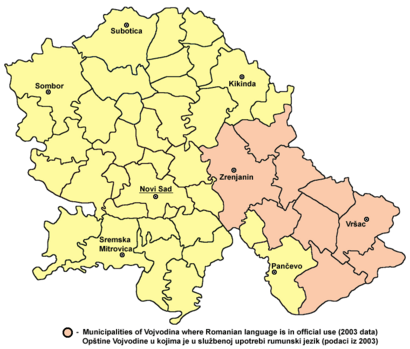
The Constitution of Serbia says that national minorities can use their own languages. In the Autonomous Province of Vojvodina, Romanian is an official language. It is used alongside Serbian, Croatian, Hungarian, Slovak, and Rusyn.
Romanian is officially used in eight towns in Vojvodina. In the town of Vršac, Romanian is official in certain villages. In the 2002 Census, 1.5% of people in Vojvodina said Romanian was their native language.
Regional Status in Ukraine
In parts of Ukraine where many Romanians live, Romanian is taught in schools. There are also Romanian-language newspapers, TV, and radio. The University of Chernivtsi trains teachers for Romanian schools.
In some areas of Ukraine, Romanian has been declared a "regional language". This means it has special status alongside Ukrainian.
In Other Places
Romanian is an official language in groups like the Latin Union and the European Union. It is also one of the languages used for religious services in Mount Athos.
Learning Romanian as a Second Language
Romanian is taught in areas with Romanian minority groups, like Vojvodina, Bulgaria, Ukraine, and Hungary. The Romanian Cultural Institute offers summer courses for teachers.
Many non-Romanians also study Romanian as a foreign language. It is taught in universities in Germany, France, Italy, the Netherlands, and the United States. Overall, Romanian is taught as a foreign language in 43 countries.
Romanian in Pop Culture
Romanian has become popular in other countries through movies and songs. Bands like O-Zone had huge hits like Dragostea Din Tei (also known as "Numa Numa"). Other artists like Akcent, Activ, DJ Project, SunStroke Project, Alexandra Stan, and Inna have also been very successful.
Romanian movies have also won awards at the Cannes Film Festival. Some artists have even written songs about the Romanian language itself. For example, O-Zone released "Nu mă las de limba noastră" ("I won't forsake our language").
How Romanian is Classified
A Romance Language
Romanian is a Romance language. This means it belongs to the Italic branch of the Indo-European language family. It shares many things with languages like French, Italian, Spanish, and Portuguese.
However, the languages most similar to Romanian are other Balkan Romance languages. These are spoken south of the Danube River. They include Aromanian, Megleno-Romanian, and Istro-Romanian.
Some linguists call Romanian "Daco-Romanian". This helps tell it apart from the other Balkan Romance languages. It refers to the area where it is spoken, which was once the Roman province of Dacia.
Compared to other Romance languages, Italian is the closest to Romanian. Romanian has been influenced by more foreign languages than Italian. A study in 1949 looked at how much languages changed from Latin. Romanian was found to be 23.5% different from Latin. Italian was 12% different, and French was 44% different.
Romanian's vocabulary is very similar to Italian (77% similar). It's also quite similar to French (75%), Spanish (71%), and Portuguese (72%). In the 1800s and early 1900s, Romanian vocabulary was heavily influenced by French and Italian.
Balkan Language Area
The Dacian language was an ancient language spoken by the Dacians. It was mostly spoken north of the Danube River. It might have been the first language to influence the Latin spoken in Dacia. However, we don't know much about it.
About 300 words found only in Romanian or in Albanian language might come from Dacian. Examples include barză ("stork") and brânză ("cheese"). Some of these words are about pastoral life (like herding animals).
While most of Romanian grammar comes from Latin, some features are shared only with other languages in the Balkan language area. These languages include Bulgarian, Macedonian, Albanian, Greek, and Serbo-Croatian. These shared features include a definite article placed at the end of a word. Also, the genitive and dative cases are often the same. The way the future tense is formed is also similar.
Slavic Influence
Slavic languages have influenced Romanian a lot. This is especially true for its vocabulary. About 10–15% of modern Romanian words come from Slavic languages. Slavic influence also shows in how Romanian sounds and how its sentences are built.
Many Slavic words came from Old Church Slavonic. This was the official written language in Wallachia and Moldavia for centuries. It was also the church language. Because of this, many Romanian words about religion come from Slavic.
The large number of Slavic words suggests that Romanians lived alongside South Slavic tribes around the 6th century. Words borrowed this way are often everyday words. Some scholars even thought Romanian was a Slavic language because of this strong influence.
Other Influences
Before the 1800s, Romanian also came into contact with several other languages:
- German: Words like cartof ("potato") from Kartoffel, and bere ("beer") from Bier. Many German words came during the rule of the Austrian Empire in parts of Romania. These words are often about military, administration, or technology.
- Greek: Words like folos ("use") from ófelos, and buzunar ("pocket") from buzunára. Greek words entered Romanian through trade and the Byzantine Empire.
- Hungarian: Words like a cheltui ("to spend") from költeni, and oraș ("city") from város.
- Turkish: Words like papuc ("slipper") from pabuç, and ciorbă ("sour soup") from çorba.
- Romani: This language gave Romanian some slang words. Examples include mișto ("good, cool") and gagică ("girlfriend").
French, Italian, and English Words
Since the 1800s, many new words have been borrowed from French and Italian. For example, birou ("desk, office") and avion ("airplane"). It's thought that about 38% of Romanian words come from French and/or Italian. If you add these to the original Latin words, about 75%–85% of Romanian words can be traced back to Latin.
Using these new French and Italian words has made many older Slavic words less common. French and Italian are also better known in Romania than in neighboring countries. In Moldova, changing to the Latin alphabet and using more Latin-based words has made the language even more like Latin.
In the 20th century, more and more English words have been borrowed. Examples include gem (from jam), interviu (from interview), and manager. These English words are given Romanian grammatical genders. For example, "the manager" becomes managerul.


